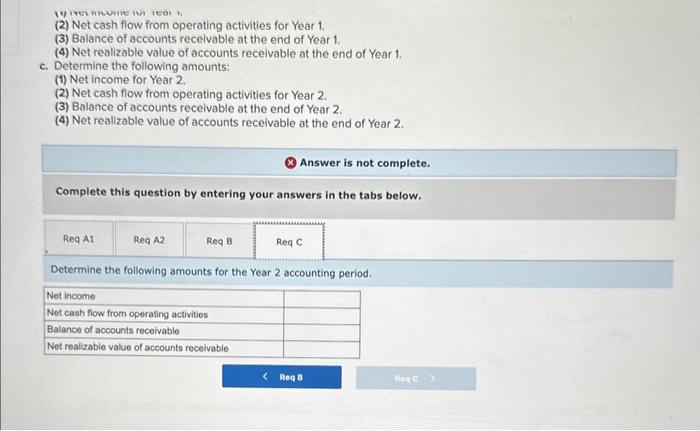Rosie Dry Cleaning was started on January 1, Year 1. It experienced the following events during its first fwo years of operation: Events Affecting Year 1 1. Provided $45,000 of cleaning services on account. 2. Collected $39,000 cash from accounts recelvable. 3. Adjusted the accounting records to reflect the estimate that uncollectible accounts expense would be 1 percent of the cleaning revenue on account. Events Affecting Year 2 1. Wrote off a $300 account receivable that was determined to be uncollectible. 2. Provided $62,000 of cleaning services on account. 3. Collected $61,000 cash from accounts recelvable. 4. Adjusted the accounting records to reflect the estimate that uncollectible accounts expense would be 1 percent of the cleaning revenue on account. Required: a. Organize the transaction data in accounts under an accounting equation for each year. b. Determine the following amounts: (1) Net income for Year 1. (2) Net cash flow from operating activities for Year 1 . (3) Balance of accounts receivable at the end of Year 1. (4) Net realizable value of accounts receivable at the end of Year 1. c. Determine the following amounts: (1) Net income for Year 2. (2) Net cash flow from operating activities for Year 2. (3) Balance of accounts receivable at the end of Year 2. (4) Net realizable value of accounts receivable at the end of Year 2. Complete this question by entering your answers in the tabs below. Organize the transaction data in accounts under an accounting equation for Year 1 . Note: Enter any decreases to account balances with a minus sign. Not all cells require input. (3) balance of accounts receivadie at the enu oi reaf . (4) Net realizable value of accounts receivable at the end of Year 2. (x) Answer is not complete. Complete this question by entering your answers in the tabs below. Organize the transaction data in accounts under an accounting equation for Year 2. Note: Enter any decreases to account balances with a minus sign. Not all cells require input. (1) iver nicume tor ied a (2) Net cash flow from operating activities for Year 1 . (3) Balance of accounts receivable at the end of Year 1 . (4) Net realizable value of accounts receivable at the end of Year 1. c. Determine the following amounts: (1) Net income for Year 2. (2) Net cash flow from operating activities for Year 2. (3) Balance of accounts recelvable at the end of Year 2 . (4) Net realizable value of accounts recelvable at the end of Year 2 . (x) Answer is not complete. Complete this question by entering your answers in the tabs below. Determine the following amounts for the Year 1 accounting period, IV Net hicutie in tea it (2) Net cash flow from operating activities for Year 1. (3) Balance of accounts receivable at the end of Year 1 . (4) Net realizable value of accounts receivable at the end of Year 1. c. Determine the following amounts: (1) Net income for Year 2 . (2) Net cash flow from operating activities for Year 2 . (3) Balance of accounts receivable at the end of Year 2. (4) Net realizable value of accounts receivable at the end of Year 2. Answer is not complete. Complete this question by entering your answers in the tabs below. Determine the following amounts for the Year 2 accounting period











